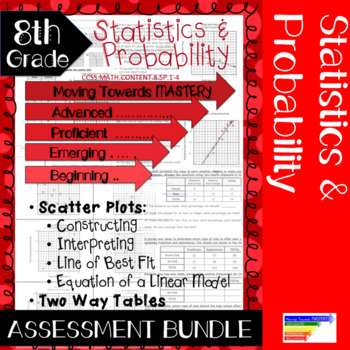8th Grade Common Core Statistics & Probability Assessments
- Zip
- Easel Activity
Products in this Bundle (8)
showing 1-5 of 8 products
Bonus
Also included in
- 8th Grade Common Core Resources:Resources using Google Apps:Number System♦ Rational & Irrational Numbers: Interactive Slides, Digital Assessment♦ Understanding Pi Digital Breakout♦ Self Checking ActivitiesExpressions & Equations♦ Exponents Rules: Interactive Slides, Quiz♦ Square Roots &Price $220.00Original Price $251.75Save $31.75
Description
This bundle includes 2 assessments for each 8th grade common core statistics and probability standard. As a bonus for buying the complete set of assessments, I have included a poster/printable for each standard addressing the levels of mastery.
Each assessment is created to determine the level of mastery of each standard.
Levels of mastery are:
→ Beginning
→ Emerging
→ Proficient
→ Advanced
The first assessment can be used for multiple purposes:
→ Pre-test
→ Study Guide
→ Reassessment
The second assessment is my primary assessment tool.
Included in the bundle is the levels of mastery posters/printables to be displayed while teaching the standards. The levels of mastery posters/printables give students a description of what is expected to move from one level of mastery to the next.






